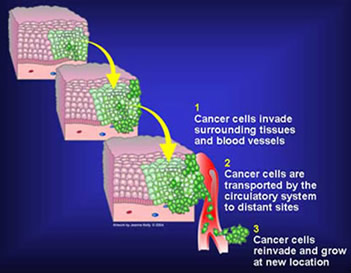Understanding Cancer
 Cancer begins in cells, the building blocks that make up tissues. Tissues make up the organs of the body. Normally, cells grow and divide to form new cells as the body needs them. When cells grow old, they die, and new cells take their place. Sometimes, this orderly process goes wrong. New cells form when the body does not need them, and old cells do not die when they should. These extra cells can form a mass of tissue called a growth or tumor. Tumors can be benign or malignant.
Cancer begins in cells, the building blocks that make up tissues. Tissues make up the organs of the body. Normally, cells grow and divide to form new cells as the body needs them. When cells grow old, they die, and new cells take their place. Sometimes, this orderly process goes wrong. New cells form when the body does not need them, and old cells do not die when they should. These extra cells can form a mass of tissue called a growth or tumor. Tumors can be benign or malignant.
How Cancer Spreads
Cancer cells can break away from a malignant tumor and spread to other parts of the body. Cancer cells spread by entering the bloodstream or the lymphatic system. The cancer cells form new tumors that damage other organs.
 When cancer spreads outside its original site, which is called metastasis, cancer cells are often found in nearby lymph nodes. If cancer cells have reached these nodes, they may also have spread to other lymph nodes or other organs.
When cancer spreads outside its original site, which is called metastasis, cancer cells are often found in nearby lymph nodes. If cancer cells have reached these nodes, they may also have spread to other lymph nodes or other organs.
When cancer spreads from its original place to another part of the body, the new tumor has the same kind of abnormal cells and the same name as the original tumor. For example, if colorectal cancer spreads to the liver, the cancer cells in the liver are actually colorectal cancer cells. The disease is metastatic colorectal cancer, not liver cancer. For that reason, it is treated as colorectal cancer, not liver cancer. Doctors call the new tumor "distant" or metastatic disease.
Malignant vs. Benign Tumors
Benign tumors are not cancer. Benign tumors are rarely life-threatening. Most benign tumors can be removed. They usually do not grow back. Benign tumors do not invade the tissues around them. Cells from benign tumors do not spread to other parts of the body.
Malignant tumors are cancer. They are generally more serious than benign tumors. Malignant tumors often can be removed, but sometimes they grow back. Malignant tumors can invade and damage nearby tissues and organs, becoming life-threatening.
Illustrations courtesy of the National Cancer Institute
